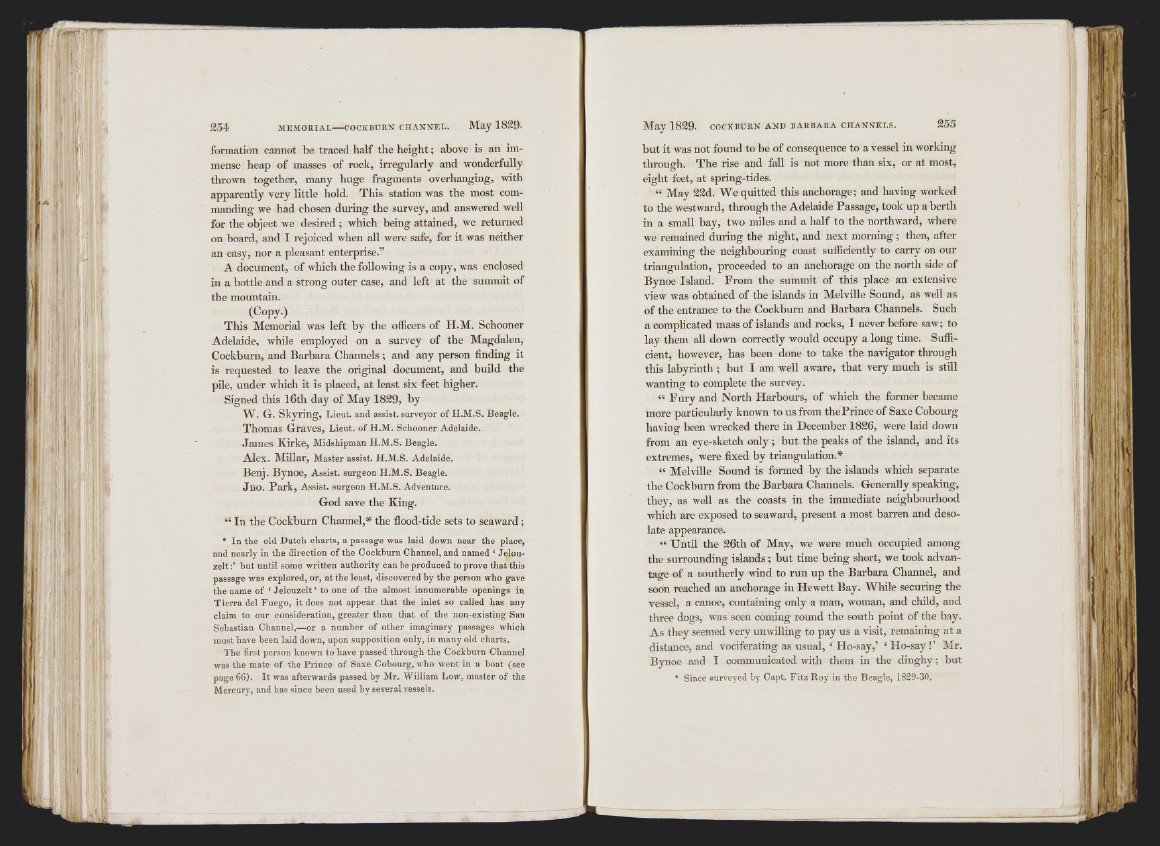
i'
formation cannot be traced half the height; above is an immense
heap of masses of rock, irregularly and wonderfully
thrown together, many huge fragments overhanging, with
apparently very little hold. This station was the most commanding
we had chosen during the survey, and answered well
for the object we desired; which being attained, we returned
on hoard, and I rejoiced when all were safe, for it was neither
an easy, nor a pleasant enterprise.”
A document, of which the following is a copy, was enclosed
in a bottle and a strong outer case, and left at the summit of
the mountain.
(Copy.)
This Memorial was left by the officers of H.M. Schooner
Adelaide, while employed on a survey of the Magdalen,
Coekburn, and Barbara Channels ; and any person finding it
is requested to leave the original document, and build the
pile, under which it is placed, at least six feet higher.
Signed this 16th day of May 1829, by
W . G . S k y r in g , Lieut, and assist, surveyor of H.M.S. Beag;le.
Thomas Graves, Lieut, of H.M. Schooner Adelaide.
James K ir k e , Midshipman H.M.S. Beagle.
Alex. Millar, Master assist. H.M.S. Adelaide.
B e n j. B y n o e , Assist, surgeon H.M.S. Beagle.
Jno. Park, Assist, surgeon H.M.S. Adventure.
God save the King.
“ In the Coekburn Channel,* the flood-tide sets to seaward;
• In the old Dutch charts, a passage was laid down ne ar the place,
and nearly in the direction of the Coekburn Channel, and named ‘ Jelou-
z e l t b u t until some written authority can be produced to prove th a t this
passage was explored, or, at the least, discovered by the person who gave
the name of ‘ J e lo u z e lt’ to one of the almost innumerable openings in
T ie r ra del Fuego, it does not appear that the inlet so called has any
claim to our consideration, greater than tha t of the non-existing San
Sebastian Channel,.—or a number of other imaginary passages which
must have heen laid down, upon supposition only, in many old charts.
The first person known to have passed through the Coekburn Channel
was the mate of the Prince of Saxe Cobourg, who went in a boat (see
page 66). I t was afterwards passed by Mr. William Low, master of the
Mercury, and has since been used by several vessels.
but it was not found to be of consequence to a vessel in working
through. The rise and fall is not more than six, or at most,
eight feet, at spring-tides.
“ May 22d. We quitted this anchorage; and having worked
to the westward, through the Adelaide Passage, took up a berth
in a small bay, two miles and a half to the northward, where
we remained during the night, and next morning; then, after
examining the neighbouring coast sufficiently to carry on our
triangulation, proceeded to an anchorage on the north side of
Bynoe Island. From the summit of this place an extensive
view was obtained of the islands in Melville Sound, as well as
of the entrance to the Cockburn and Barbara Channels. Such
a complicated mass of islands and rocks, I never before saw; to
lay them all down correctly would occupy a long time. Sufficient,
however, has been done to take the navigator through
this labyrinth; but I am well aware, that very much is still
wanting to complete the survey.
“ Fury and North Harbours, of which the former became
more particularly known to us from the Prince of Saxe Cobourg
having been wrecked there in December 1826, were laid down
from an eye-sketch only; but the peaks of the island, and its
extremes, were fixed by triangulation.*
“ Melville Sound is formed by the islands which separate
the Cockburn from the Barbara Channels. Generally speaking,
they, as well as the coasts in the immediate neighbourhood
which are exposed to seaward, present a most barren and desolate
appearance.
“ Until the 26th of May, we were much occupied among
the surrounding islands; hut time being short, we took advantage
of a southerly wind to run up the Barbara Channel, and
soon reached an anchorage in Hewett Bay. While securing the
vessel, a canoe, containing only a man, woman, and child, and
three dogs, was seen coming round the south point of the bay.
As they seemed very unwilling to pay us a visit, remaining at a
distance, and vociferating as usual, ‘ Ho-say,’ ‘ Ho-say !’ Mr.
Bynoe and I communicated with them in the dinghy; but
• Since surveyed by Capt. F itz Roy in the Beagle, 1829-30.
l l
iM
I 4